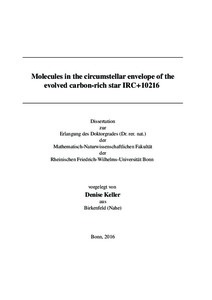Keller, Denise: Molecules in the circumstellar envelope of the evolved carbon-rich star IRC+10216. - Bonn, 2017. - Dissertation, Rheinische Friedrich-Wilhelms-Universität Bonn.
Online-Ausgabe in bonndoc: https://nbn-resolving.org/urn:nbn:de:hbz:5n-46152
Online-Ausgabe in bonndoc: https://nbn-resolving.org/urn:nbn:de:hbz:5n-46152
@phdthesis{handle:20.500.11811/7112,
urn: https://nbn-resolving.org/urn:nbn:de:hbz:5n-46152,
author = {{Denise Keller}},
title = {Molecules in the circumstellar envelope of the evolved carbon-rich star IRC+10216},
school = {Rheinische Friedrich-Wilhelms-Universität Bonn},
year = 2017,
month = mar,
note = {Modern radio interferometers allow the imaging of spectral line emission over a wide range of frequencies with high angular resolution. In this thesis we present a detailed empirical examination and description of the molecules in the circumstellar envelope (CSE) of the evolved carbon-rich star IRC+10216 between 18 and 40 GHz obtained with the Karl G. Jansky Very Large Array (VLA). The interferometric mapping of the molecular emission in the radio regime has been fairly unexplored for this star. Therefore, this spectral line and imaging survey is an important addition to the studies of IRC+10216. By constraining the molecular spatial distribution, the understanding of the formation and shaping of the observed CSE morphology and the inherent chemistry is greatly improved in the cool (10-500 K) outer CSE.
Most detected species are carbon-bearing molecules and are distributed in hollow spheres around the star. We focus on the cyanopolyynes and carbon chains that are the brightest transitions and trace the UV-photon induced chemistry. The substructure of these hollow spheres are shells, arcs, and clumps. With a new automatized procedure, we perform a detailed spatio-kinematical study of the images of the molecular line transitions. This work quantifies the three dimensional physical and chemical structure and substructure of IRC+10216 in unique detail.
We find a main molecular shell component at an angular distance of about 15 arcsec (corresponding to ~500 stellar radii) and for the first time constrain a second shell component at 22-23 arcsec from the star. Both components have a thickness of about 4-8 arcsec, so they are mostly resolved. The morphology is non-concentric, non-regular, and has asymmetries with clear differences in the detailed substructure.
We qualitatively compare the VLA observations to state-of-the-art chemical models. Overall, we find a good correspondence between the azimuthally averaged data and the models. There are deviations in the substructure within the different image quarters, especially for the carbon chains C4H and C6H. The models do not completely reproduce the observations in a consistent way. Therefore, our VLA data provide excellent material to improve future chemical and radiative transfer models of the CSE of IRC+10216 and of AGB stars in general.
With the extracted information on the shell geometry from the VLA data, we are able to perform an approximate physical analysis of the CSE. We estimate molecular column densities and abundances of HC3N and HC5N. Especially for HC5N the results compare well with previous studies. Furthermore, we discuss the effect of a more realistic density structure which includes density-enhanced shells in the circumstellar medium.},
url = {https://hdl.handle.net/20.500.11811/7112}
}
urn: https://nbn-resolving.org/urn:nbn:de:hbz:5n-46152,
author = {{Denise Keller}},
title = {Molecules in the circumstellar envelope of the evolved carbon-rich star IRC+10216},
school = {Rheinische Friedrich-Wilhelms-Universität Bonn},
year = 2017,
month = mar,
note = {Modern radio interferometers allow the imaging of spectral line emission over a wide range of frequencies with high angular resolution. In this thesis we present a detailed empirical examination and description of the molecules in the circumstellar envelope (CSE) of the evolved carbon-rich star IRC+10216 between 18 and 40 GHz obtained with the Karl G. Jansky Very Large Array (VLA). The interferometric mapping of the molecular emission in the radio regime has been fairly unexplored for this star. Therefore, this spectral line and imaging survey is an important addition to the studies of IRC+10216. By constraining the molecular spatial distribution, the understanding of the formation and shaping of the observed CSE morphology and the inherent chemistry is greatly improved in the cool (10-500 K) outer CSE.
Most detected species are carbon-bearing molecules and are distributed in hollow spheres around the star. We focus on the cyanopolyynes and carbon chains that are the brightest transitions and trace the UV-photon induced chemistry. The substructure of these hollow spheres are shells, arcs, and clumps. With a new automatized procedure, we perform a detailed spatio-kinematical study of the images of the molecular line transitions. This work quantifies the three dimensional physical and chemical structure and substructure of IRC+10216 in unique detail.
We find a main molecular shell component at an angular distance of about 15 arcsec (corresponding to ~500 stellar radii) and for the first time constrain a second shell component at 22-23 arcsec from the star. Both components have a thickness of about 4-8 arcsec, so they are mostly resolved. The morphology is non-concentric, non-regular, and has asymmetries with clear differences in the detailed substructure.
We qualitatively compare the VLA observations to state-of-the-art chemical models. Overall, we find a good correspondence between the azimuthally averaged data and the models. There are deviations in the substructure within the different image quarters, especially for the carbon chains C4H and C6H. The models do not completely reproduce the observations in a consistent way. Therefore, our VLA data provide excellent material to improve future chemical and radiative transfer models of the CSE of IRC+10216 and of AGB stars in general.
With the extracted information on the shell geometry from the VLA data, we are able to perform an approximate physical analysis of the CSE. We estimate molecular column densities and abundances of HC3N and HC5N. Especially for HC5N the results compare well with previous studies. Furthermore, we discuss the effect of a more realistic density structure which includes density-enhanced shells in the circumstellar medium.},
url = {https://hdl.handle.net/20.500.11811/7112}
}






